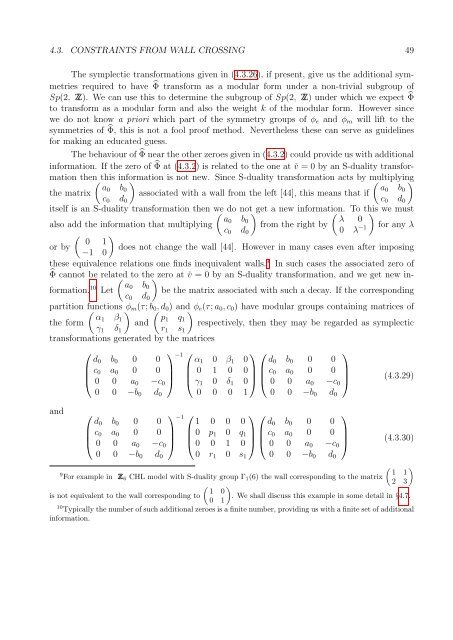PHYS08200604018 Shamik Banerjee - Homi Bhabha National ...
PHYS08200604018 Shamik Banerjee - Homi Bhabha National ...
PHYS08200604018 Shamik Banerjee - Homi Bhabha National ...
Create successful ePaper yourself
Turn your PDF publications into a flip-book with our unique Google optimized e-Paper software.
4.3. CONSTRAINTS FROM WALL CROSSING 49<br />
The symplectic transformations given in (4.3.26), if present, give us the additional symmetries<br />
required to have ̂Φ transform as a modular form under a non-trivial subgroup of<br />
Sp(2, Z). We can use this to determine the subgroup of Sp(2, Z) under which we expect ̂Φ<br />
to transform as a modular form and also the weight k of the modular form. However since<br />
we do not know a priori which part of the symmetry groups of φ e and φ m will lift to the<br />
symmetries of ̂Φ, this is not a fool proof method. Nevertheless these can serve as guidelines<br />
for making an educated guess.<br />
The behaviour of ̂Φ near the other zeroes given in (4.3.2) could provide us with additional<br />
information. If the zero of ̂Φ at (4.3.2) is related to the one at ˇv = 0 by an S-duality transformation<br />
then( this information ) is not new. Since S-duality transformation acts by multiplying ( )<br />
a0 b<br />
the matrix<br />
0<br />
a0 b<br />
associated with a wall from the left [44], this means that if<br />
0<br />
c 0 d 0 c 0 d 0<br />
itself is an S-duality transformation then we ( do not)<br />
get a new information. ( To this ) we must<br />
a0 b<br />
also add the information that multiplying<br />
0<br />
λ 0<br />
from the right by<br />
c 0 d 0 0 λ −1 for any λ<br />
( )<br />
0 1<br />
or by<br />
does not change the wall [44]. However in many cases even after imposing<br />
−1 0<br />
these equivalence relations one finds inequivalent walls. 9 In such cases the associated zero of<br />
̂Φ cannot be related ( to the)<br />
zero at ˇv = 0 by an S-duality transformation, and we get new information.<br />
10 a0 b<br />
Let<br />
0<br />
be the matrix associated with such a decay. If the corresponding<br />
c 0 d 0<br />
partition functions ( ) φ m (τ; b( 0 , d 0 ) and)<br />
φ e (τ; a 0 , c 0 ) have modular groups containing matrices of<br />
α1 β<br />
the form<br />
1 p1 q<br />
and<br />
1<br />
respectively, then they may be regarded as symplectic<br />
γ 1 δ 1 r 1 s 1<br />
transformations generated by the matrices<br />
and<br />
⎛<br />
⎞<br />
d 0 b 0 0 0<br />
⎜ c 0 a 0 0 0<br />
⎟<br />
⎝ 0 0 a 0 −c 0<br />
⎠<br />
0 0 −b 0 d 0<br />
⎛<br />
⎞<br />
d 0 b 0 0 0<br />
⎜ c 0 a 0 0 0<br />
⎟<br />
⎝ 0 0 a 0 −c 0<br />
⎠<br />
0 0 −b 0 d 0<br />
⎞ ⎛<br />
⎞<br />
α 1 0 β 1 0 d 0 b 0 0 0<br />
⎜ 0 1 0 0<br />
⎟ ⎜ c 0 a 0 0 0<br />
⎟<br />
⎝ γ 1 0 δ 1 0 ⎠ ⎝ 0 0 a 0 −c 0<br />
⎠ (4.3.29)<br />
0 0 0 1 0 0 −b 0 d 0<br />
−1 ⎛<br />
⎞ ⎛<br />
⎞<br />
1 0 0 0 d 0 b 0 0 0<br />
⎜ 0 p 1 0 q 1<br />
⎟ ⎜ c 0 a 0 0 0<br />
⎟<br />
⎝ 0 0 1 0 ⎠ ⎝ 0 0 a 0 −c 0<br />
⎠ (4.3.30)<br />
0 r 1 0 s 1 0 0 −b 0 d 0<br />
−1 ⎛<br />
( )<br />
1 1<br />
9 For example in Z 6 CHL model with S-duality group Γ 1 (6) the wall corresponding to the matrix<br />
( )<br />
2 3<br />
1 0<br />
is not equivalent to the wall corresponding to . We shall discuss this example in some detail in §4.7.<br />
0 1<br />
10 Typically the number of such additional zeroes is a finite number, providing us with a finite set of additional<br />
information.

















